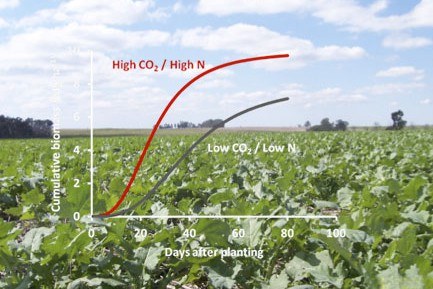The model Cycles simulates agricultural productivity (grain, forage and biomass yield) and the water, carbon and nitrogen balance of soil-crop systems subject to different climate, soil and management constraints. The Cycles-L (L stands for landscape) version simulates these processes at a watershed-scale and includes water and nutrient transport through surface, groundwater, and streams. A description of Cycles-L can be found here: https://doi.org/10.1029/2022WR033453

Cycles simulates the response of vegetation to soil and atmospheric forcing. The picture shows a canola canopy. Photo credit S. Mazzilli.

Model developers: Armen R. Kemanian, Charlie M. White, Yuning Shi and Claudio O. Stockle
Software architect: Lorne Leonard
[The following link is temporary down for maintenance.]
https://www.cycles-model.psu.edu/Cycles/CyclesModel.html
[Cycles can be temporarily accessed here at the link below.]
https://hydroterremodels.psu.edu/CYCLES/CyclesModel.html
GitHub repository and versioning: Yuning Shi
https://github.com/PSUmodeling/Cycles/releases
User's Guide: Yuning Shi, Charlie M. White and Armen R. Kemanian
https://psumodeling.github.io/Cycles/
Cycles is an agroecosystem simulation model. It is a multi-year, multi-crop, multi-soil-layered, one-dimensional, daily or sub-daily time step platform that simulates water, carbon and nitrogen balance of the soil-crop system subject to climate conditions and a large array of management forcings. It belongs to the family of mechanistic or process-based models.
Cycles needs inputs of initial soil properties, climate forcings at a daily time step, and the management practices or forcings imposed by the farm operator such as crop sequence, fertilization rates and timing, irrigation and tillage. Based on these inputs, Cycles simulates crop growth and nutrient cycling and predicts agricultural performance metrics for annual and perennial crops (grain and forage yield, nutrient and water use efficiency), and environmental performance metrics such as nutrient losses through different pathways to the environment.
Many modules in Cycles are related to the model CropSyst (Stöckle et al, 2014). The fundamental heat and water transport algorithms are adapted from Campbell (1985) Soil Physics with Basic landmark book. The modular Cycles is easily unplugged from the main interface, which permits an efficient addition / removal of algorithms and coupling with watershed simulation models. Cycles has unique solutions to the coupled cycling of carbon, nitrogen and water in the soil-plant-atmospheric system. Among the original components in Cycles are: new developments in carbon and nitrogen saturation theory (soil); an old but robust implementation of stomatal optimization theory (vegetation) to simulate plant growth, water use efficiency, and the response of crops to increasing carbon dioxide; and the simulation of polycultures (multispecies pastures, silage and cover crops).
The philosophy behind Cycles is that the outcomes of interest must emerge from fundamental principles. The model is meant to help framing questions and providing insightful answers to address disciplinary and multidisciplinary problems. It can be used as well as a decision support tool for improved agricultural management and environmental stewardship. Current developments focus on integrating Cycles to PIHM for a tridimensional representation of the landscape that includes rivers, lakes and groundwater. This integration will remove simplifications needed to operate in one dimension and will expand the model's domain of application as landscape properties become intrinsic components of the simulations.

